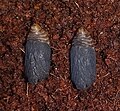Parnassius actius
| Parnassius actius | |
|---|---|
 | |
| Syntype of P. actius actinobolus (female) from Bogdo Ula in collection of Ulster Museum | |
| Scientific classification | |
| Domain: | Eukaryota |
| Kingdom: | Animalia |
| Phylum: | Arthropoda |
| Class: | Insecta |
| Order: | Lepidoptera |
| Family: | Papilionidae |
| Genus: | Parnassius |
| Species: | P. actius |
| Binomial name | |
| Parnassius actius Eversmann, 1843 | |
Parnassius actius, also known as the scarce red apollo,[1] is a high-altitude butterfly found in Central Asia. It is a member of the snow Apollo genus (Parnassius) of the swallowtail family (Papilionidae).
Range
Found in Turkmenistan, Uzbekistan, Tajikistan, Kyrgyzstan, north-eastern Afghanistan, Indus Valley (Pakistan) and (Jammu and Kashmir) and south-western China, including Xinjiang.
Description
Note: The wing pattern in Parnassius species is inconsistent and the very many subspecies and forms make identification problematic and uncertain. Structural characters derived from the genitalia, wing venation, sphragis and foretibial epiphysis are more, but not entirely reliable. The description given here is a guide only. For an identification key see P.R. Ackery (1975).[2]
P. actius can be recognized by the more elongate and a little more pointed forewing. Ground colour usually pure white, more rarely slightly yellowish; vitreous margin of forewing narrow, as a rule not reaching the posterior angle, or the edge itself posteriorly narrowly white: submarginal spots feebly developed; in male usually only the anterior costal spot centred with red, in female both spots. The male, besides, somewhat duller, hindmarginal spot of forewing sometimes also marked with red, the submarginal markings more strongly developed. Hindwing grey at the base in both sexes, only in rare exceptional cases with a red basal spot above.[3]
Status
It is a rare butterfly and declining due to changes in its habitat and is thus considered to be vulnerable. More information is needed on this species.
Gallery
-
 Biotop
Biotop -
 pairing
pairing -
 Eggs
Eggs -
 larva
larva -
 Pupae
Pupae
See also
- Papilionidae
- List of butterflies of India
- List of butterflies of India (Papilionidae)
References
- ^ Varshney, R.K.; Smetacek, Peter (2015). A Synoptic Catalogue of the Butterflies of India. Butterfly Research Centre, Bhimtal & Indinov Publishing, New Delhi. Retrieved 20 April 2020.
- ^ Ackery P.R. (1975) A guide to the genera and species of Parnassiinae (Lepidoptera:Papilionidae). Bull. Br. Mus. nat. Hist. (Ent.) 31, 4 pdf
- ^ Stichel in Seitz, 1906 (Parnassius). Die Groß-Schmetterlinge der Erde. Die Groß-Schmetterlinge des palaearktischen Faunengebietes. Die palaearktischen Tagfalter, Stuttgart.
- Collins, N. Mark; Morris, Michael G. (1985). Threatened Swallowtail Butterflies of the World: The IUCN Red Data Book. Gland & Cambridge: IUCN. ISBN 978-2-88032-603-6 – via Biodiversity Heritage Library.
- Evans, W.H. (1932). The Identification of Indian Butterflies (2nd ed.). Mumbai, India: Bombay Natural History Society.
- Haribal, Meena (1992). The Butterflies of Sikkim Himalaya and Their Natural History. Gangtok, Sikkim, India: Sikkim Nature Conservation Foundation.
- Wynter-Blyth, Mark Alexander (1957). Butterflies of the Indian Region. Bombay, India: Bombay Natural History Society. ISBN 978-8170192329.
- Sakai S., Inaoka S., Toshiaki A., Yamaguchi S., Watanabe Y., (2002) The Parnassiology. The Parnassius Butterflies, A Study in Evolution, Kodansha, Japan.
- Weiss J.-C., (2005) Parnassiinae of the World - Part 4, Hillside Books, Canterbury, UK.[1]
Further reading
- sv:Parnassius actius - Swedish Wikipedia provides further references and synonymy
External links
- P. actius images at Consortium for the Barcode of Life
- Parnassius actius
- Parnassius gallery
- v
- t
- e

















